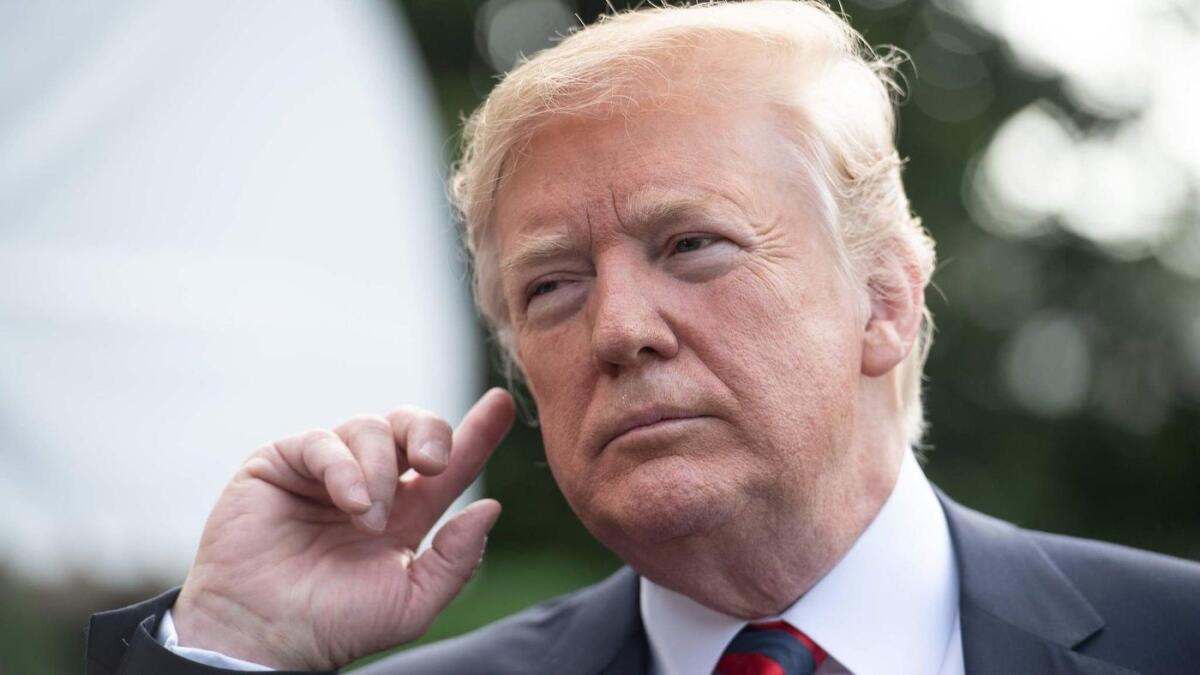Pentagon to create new command for fighting in space, but resists Trump’s proposed ‘space force’

Reporting from Washington — The Pentagon plans to create a new military command responsible for war fighting in space, but opposition in Congress could block a more ambitious “space force,” a new military service that President Trump has endorsed repeatedly in tweets and campaign rallies.
The outcome of the bureaucratic reshuffling could have major implications for Los Angeles. More than 6,000 personnel are based at the Air Force’s Space and Missile Systems Center in El Segundo, which does most of the service’s space planning and procurement.
Trump’s idea for a futuristic space service has raised deep concerns among some military officials and senior Pentagon commanders, especially in the Air Force. They fear losing responsibility for space and the nearly $8.5 billion of its budget that now goes for building and launching satellites, along with other space systems.
Vice President Mike Pence will renew the administration’s call for a space force in a speech at the Pentagon on Thursday. Deputy Defense Secretary Patrick Shanahan will lay out interim steps, including establishing a space command and a new joint agency for buying satellites, which the Pentagon plans to create by the end of the year.
According to a Pentagon report to be released Thursday, the new “U.S. Space Command” would be responsible for drafting war plans for space and for conducting military operations in space, much like Central Command draws from all military services and is responsible for fighting wars in the Middle East.
Trump’s broader call for a space force as a new branch of the armed services — joining the Army, Air Force, Navy, Marines and Coast Guard — faces an uncertain future. It can only be implemented with the approval of Congress. Senior lawmakers in the Senate have voiced staunch opposition to the idea, which is unlikely to be taken up until next year in any case.
If Congress eventually approves a space force, it would probably have 30,000 to 40,000 personnel, drawn mostly from the Air Force but also from the Army and possibly the National Reconnaissance Office, the little-known intelligence agency responsible for building and launching spy satellites.
That would make the space force by far the smallest military service, behind the Marine Corps, which has an active duty force of 186,100 this year.
Defense Secretary James N. Mattis played down the disagreements between the Pentagon and the White House on Tuesday. “We are in complete agreement with the president’s concerns about protecting our assets in space,” he told reporters, adding, “I don’t have all the final answers yet.”
Current and former Pentagon officials say consolidation of space functions now performed by the Air Force, Navy and other military branches into a single independent service would add layers of bureaucracy and might not immediately improve the military’s capabilities.
“The Pentagon is complicated enough,” Air Force Secretary Heather Wilson told reporters in June 2017, when asked about a potential space force. “This will make it more complex, add more boxes to the organization chart and cost more money. If I had more money, I would put it into lethality, not bureaucracy.”
Some current and former Air Force officers cautioned Congress to go slow in reshaping the military’s space operations.
A space force must be “planned and executed deliberately,” retired Air Force Lt. Gen. David Deptula and Lt. Col. Michael Martindale, an associate director at the Air Force Academy, said in a statement released Wednesday by the Air Force Assn., an independent nonprofit professional military and aerospace group.
“By itself, standing up a U.S. Space Force will not necessarily improve the resource deficiencies” in space operations and “could pull space professionals from the community of warfighters they have worked so hard to integrate with over the past quarter century,” the statement said.
If designed like the other military services, a space force would be responsible for training and equipping personnel for warfare in space but would not engage in combat. Instead, its personnel would be assigned to the space command the Pentagon is proposing or to existing combat commands.
Trump has never explained at length why he favors creation of a space force as an additional military service, but the concept often draws loud cheers at rallies.
Hopes by Pentagon officials that the idea would fade away were dashed in June when Trump during a meeting of the National Space Council, a government advisory body, directed Marine Gen. Joseph Dunford, the chairman of the Joint Chiefs of Staff, to create a “separate but equal” military service for space.
“We got you,” a clearly uncomfortable Dunford replied.
Trump has not let the matter drop, saying at a campaign rally Saturday for a congressional candidate in Ohio that he had “directed the Pentagon to begin the process of creating the sixth branch of the United States Armed Forces called the space force. Space, very important.”
Under pressure from Pence and civilian appointees at the Pentagon, the military brass has been unable to punt the issue completely to Congress.
The Pentagon now has 11 so-called combatant commands. Eight focus on geographic regions and three have global responsibilities, such as Strategic Command, which oversees planning for nuclear war.
Instead of relying on a separate space force, the new space command would draw military personnel with space expertise from the Air Force, Navy, Marine Corps and Army, and would be headed by a four-star commander.
The Pentagon report being released Thursday is also expected to call for creation of a space development agency, which would take over responsibility for buying satellites and other military space systems.
The agency also would take over space contracting now spread across other services and agencies. The Trump administration is requesting $12.5 billion for unclassified military space programs next year. Most the money — $11.4 billion — would go to the Air Force, along with an unknown amount in classified spending.
The Pentagon had a Space Command from 1985 until 2002, when then-Secretary of Defense Donald H. Rumsfeld ordered it merged with Strategic Command partly in an effort to reduce bureaucracy and redundancy.
Complicating matters even more, the Air Force has its own lower-level Space Command. Headquartered at Peterson Air Force Base in Colorado, it oversees the Space and Missile Systems Center in El Segundo, as well missile launch operations at Vandenberg Air Force Base and other Air Force space units.
It’s not yet clear whether the Pentagon’s partial steps to unify space operations will blunt Trump’s push for congressional action on a space force.
Pentagon spending on satellites and other space programs long have been plagued by major cost overruns, delays and bureaucratic infighting. The uneven record led, in 2015, to designation of the Air Force secretary as the Defense Department’s principal space advisor, with new powers to coordinate space-related spending and planning across the department.
But the General Accountability Office, Congress’s investigative arm, last year said the problems were so severe that lawmakers should consider more far-reaching reforms, including creation of an independent space force, as Trump has recommended.
“Given the long-standing fragmentation in space leadership and consequent challenges faced by [the Defense Department] in synchronizing its extensive space enterprise, other, more significant reform measures may deserve a closer look,” the GAO said in a report to the Senate Armed Services Committee.
But the report also warned that such changes would cause “significant short-term disruption” at the Pentagon.
“Careful consideration of any such changes is therefore essential for helping to ensure a better track record of providing warfighters with the capabilities they need on time and within cost,” the GAO said.
Twitter: @davidcloudLAT
More to Read
Sign up for Essential California
The most important California stories and recommendations in your inbox every morning.
You may occasionally receive promotional content from the Los Angeles Times.











